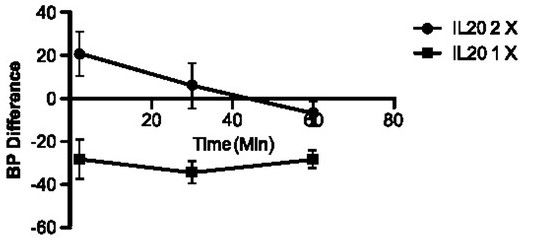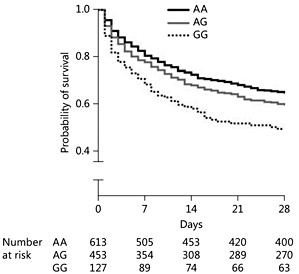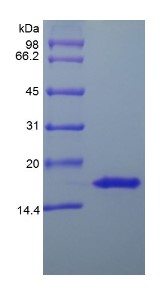Il20
-
Official Full Name
interleukin 20 -
Overview
Human IL-20 or Interleukin-20, also known as Cytokine Zcyto10, is a 176 amino acid cytokine protein expressed from the IL20 gene located at locus 1q32 on chromosome 1. After initial synthesis of the protein, it undergoes proteolytic cleavage where the 24 residue signal sequence is cleaved, allowing for the proper folding and maturation of the IL-20 cytokine. Recent studies have determined that IL-20, belonging to the IL-10 family, may be involved in epidermal function and psoriasis via signal transduction through Signal Transducer and Activator of Transcription 3 (STAT3) in keratinocytes. It is expressed at very low levels in skin, trachea and other tissues. -
Synonyms
UNQ852/PRO1801;IL-20;IL10D;ZCYTO10;cytokine Zcyto10;four alpha helix cytokine;interleukin-20
Recombinant Proteins
- Human
- Mouse
- Rat
- Horse
- E.coli
- HEK293
- GST
- Non
- His
- Fc
- DDK
- Myc
Background
What is IL20 protein
Interleukin-20 (IL20), a cytokine protein belonging to the IL-10 family, has captured the attention of molecular biologists and pharmacologists, thanks to its wide range of biological activities. Its role in signaling processes, immune-response modulation, and host defense mechanisms has made it a subject of intense study, with emphasis revolving around its structure, function, associated diseases, and consequential therapeutic applications.
In 2001, the discovery of Interleukin-20 was first reported by Gallagher, et al., with its correlation to skin biology underlining its immense importance. They identified this protein-coding cytokine within the epidermal keratinocyte, with induced epidermal thickening signifying just how deeply layered its intricacies were.
Gene Locus and Protein Structure
The IL20 is located at chromosome 1q32. Its gene locus has a denser population of IL-10 family members, an aspect that underscores its complex interactions at a genomic level. The IL-20 gene possesses five exons, with a series of Cytosine-phosphate-Guanine (CpG) islands found in its promoter region suggesting that DNA methylation could regulate its expression.
In terms of the protein structure, IL-20 is a 176-amino-acid protein, with its asparagine (N-glycosylation) sites at the 65 and 125 amino acids. These sites significantly influence structural formulation and real-time biological functioning through a disulfide bond. IL-20 represents an alpha-helical protein having inline character with other IL-10 family cytokines, such as IL-10, IL-19, and IL-24, among others.
Functions of IL20 Protein
Several studies have shown that the IL20 protein plays an integral part in the homeostasis of skin, demonstrating activities linked to keratinocyte proliferation and differentiation, as well as cutaneous inflammatory responses regulation. IL-20 primarily drives keratinocyte hyperplasia, an activity that leads to the thickening of the epidermis and the formation of a protective barrier against external pathogens.
Aside from skin defense enhancements, the IL20 cytokine also triggers the collapse of the skin barrier function, which can cause excessive inflammation, thus contributing to various inflammatory diseases like psoriasis.
IL20 Protein-Related Signal Pathway
Interleukin-20 signals via a receptor complex comprising the IL-20R1 and IL-20R2 chains, or the IL-22R1 and IL-20R2 chains. Following the binding to its receptor, IL-20 activates signaling pathways involving the Janus Kinase (JAK) and Signal Transducer and Activator of Transcriptions (STATs). The JAK/STAT pathway has been found to play a pivotal role in controlling the expression of a variety of genes that are fundamentally relevant to the immune response, cell-cycle control, apoptosis, and tumorigenesis.
IL20 Protein-Related Diseases
Overexpression or deregulation of the IL-20 protein is associated with several pathological conditions, including diseases of autoimmune and inflammatory origins. Noteworthy, IL-20 is implicated in the etiology of conditions such as psoriasis, rheumatoid arthritis, atherosclerosis, and osteoporosis.
In psoriasis, for instance, elevated levels of IL-20 have been identified as a primary contributor to the inflammatory cascades that drive disease progression. Similarly, in rheumatoid arthritis, IL-20 has been implicated in pro-inflammatory activities and bone degradation.
- Psoriasis: Increased IL-20 is implicated in pathogenesis of this chronic inflammatory skin disease.
- Atopic dermatitis: Plays a role in allergic skin inflammation commonly seen in atopic dermatitis.
- Rheumatoid arthritis: Higher levels correlated with joint inflammation and damage in rheumatoid arthritis.
- Inflammatory bowel disease: Aberrant IL-20 signaling contributes to intestinal inflammation in IBD.
IL20 Protein's Applications
With the link between IL-20 and several pathological conditions understood, the potential therapeutic applications are immense. As such, IL-20 has become a potential therapeutic target for the treatment of certain inflammatory disorders. The antagonization or neutralization of IL-20 and its associated signaling pathways could present innovative strategies for treating inflammatory diseases.
Current therapeutic measures attempt to specifically target the IL-20 protein or its receptors, with a goal of inhibiting the initiation of signaling cascades that drive disease progression. As such, the development of IL-20 antagonists, whether through monoclonal antibodies or small-molecule inhibitors, could introduce revolutionary approaches in the treatment of diseases like psoriasis, rheumatoid arthritis, and atherosclerosis.
Case Study

(Cuthbert Simpkins, 2016)
Fig2. Systolic pressures. The top line on the graph shows the result of Intralipid 20%(IL20 infused at a volume 2 × the volume of blood removed. The bottom line of the graph shows the result of IL20 infused at a volume 1 × the volume of blood removed. All of the values are normalized to the prehemorrhage blood pressure (BP), which equals 0 on this graph. (n = 6 mice for each curve).

(Further Areas, 2018)
Fig3. Survival curves for the septic shock patients by the IL20 rs2981573 genotype. Patients with the IL20 rs2981573 G allele had significantly increased 28-day mortality compared to those with the A allele in the septic shock cohort (adjusted HR 1.27; 95% CI 1.10-1.47; p = 8.0 × 10-4). The p value was calculated using the Cox regression analysis corrected for age, gender, a medical versus a surgical diagnosis, ancestry, and APACHE II score.
Quality Guarantee
High Purity

Fig1. SDS-PAGE (Cat. No.: IL20-278H)
Involved Pathway
Il20 involved in several pathways and played different roles in them. We selected most pathways Il20 participated on our site, such as Cytokine-cytokine receptor interaction,Jak-STAT signaling pathway, which may be useful for your reference. Also, other proteins which involved in the same pathway with Il20 were listed below. Creative BioMart supplied nearly all the proteins listed, you can search them on our site.
| Pathway Name | Pathway Related Protein |
|---|---|
| Jak-STAT signaling pathway | IL7R,RAF1,IL7,SOCS5,IFNA17,GH2,IL21,GFAP,Il4ra,IFNA6 |
| Cytokine-cytokine receptor interaction | CCL16,IL12RB2,IL17B,CCL18,CCR8L,GM1987,CXCL9,BMPR2,BMPR1BB,IL10RB |
Protein Function
Il20 has several biochemical functions, for example, cytokine activity,interleukin-20 receptor binding,interleukin-22 receptor binding. Some of the functions are cooperated with other proteins, some of the functions could acted by Il20 itself. We selected most functions Il20 had, and list some proteins which have the same functions with Il20. You can find most of the proteins on our site.
| Function | Related Protein |
|---|---|
| cytokine activity | MSTNB,Ifnl2,IL17A/F3,TXLNA,CCL4,IL36RN,IL23,CCL20B,IFNPHI4,BMP8B |
| interleukin-22 receptor binding | IL22 |
Interacting Protein
Il20 has direct interactions with proteins and molecules. Those interactions were detected by several methods such as yeast two hybrid, co-IP, pull-down and so on. We selected proteins and molecules interacted with Il20 here. Most of them are supplied by our site. Hope this information will be useful for your research of Il20.
Resources
Gene Families
Research Area
Related Services
Related Products
References



